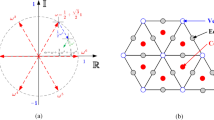Abstract
Element-partition-based methods for visualization of 3D unstructured grid data are presented. First, partition schemes for common elements, including curvilinear tetrahedra, pentahedra, hexahedra, etc., are given, so that complex elements can be divided into several rectilinear tetrahedra, and the visualization processes can be simplified. Then, a slice method for cloud map and an iso-surface method based on the partition schemes are described.
Similar content being viewed by others
References
Speray D, Kennon S. Volume probes: Interactive data exploration on arbitrary grids.Computer Graphics, 1990, 24(5): 5–12.
Lo S H. Visualization of 3D solid finite element mesh by the method of sectioning.Computer Structures, 1990, 35(1): 63–68.
Lorensen W E, Cline H E. Marching cubes: A high resolution 3D surface construction algorithm.Computer Graphics, 1987, 21(4): 163–169.
Wen Sili. Research on the visualization of 3D data fields. Ph.D. Dissertation, Institute of Computing Technology, Chinese Academy of Sciences, April 1993.
Gelder A V, Wilhelms J. Topological considerations in isosurface generation.ACM Transactions on Graphics, 1994, 13(4): 337–375.
Wu Enhua, He Ruirong. An solution of disambiguation in isosurface generation. InThe 3rd Workshop of Euro-graphics on VISC, Italy, April 1992.
Chzelle B, Palios L. Triangulating a nonconvex polytope. InProc. 5th Annual Symposium on Computational Geometry, June 1989, pp. 393–399.
Wu Junsheng. Visualization techniques and their realizations in finite element analyses and computations.Chinese J. Computer Aided Engineering, 1995, 4(1): 47–52.
Liu D, Hoschek G. GC’ Continuity conditions between adjacent rectangular and triangular Bézier surface patches.CAD, 1989, 21(4).
Zhou Yong, Chen Weihai, Tang Zesheng. An elaborate ambiguity detection method for constructing isosurfaces within tetrahedral meshes.Computer and Graphics, 1995, 19(3): 355–364.
Giertsen C. Volume visualization of sparse irregular meshes.IEEE CG/G, 1992, 12(2): 40–48.
Author information
Authors and Affiliations
Additional information
This work is supported by Aeronautical Scientific Research Foundation of China.
Wu Junsheng received the M.Sc. degree in computer application software from Aeronautics Computing Technique Research Institute (ACTRI) in 1990, and the Ph.D. degree from Northwestern Polytechnic University in Xi’an in 1997. Now, he is a Professor of Computer Network and Management Information System Research Department in ACTRI. His research interests are CAD, computer graphics and scientific visualization.
Wu Guangmao graduated from Peking University in 1965. He is currently a Professor and a Chief Engineer of Aeronautics Computing Technique Research Institute, he is also a Chief Designer of Golden Aviation Engineering Project, Aviation Industries of China. His research interests are CAD, computer graphics, software engineering and computer network.
Rights and permissions
About this article
Cite this article
Wu, J., Wu, G. Element-partition-based methods for visualization of 3D unstructured grid data. J. of Comput. Sci. & Technol. 13, 417–425 (1998). https://doi.org/10.1007/BF02948500
Received:
Revised:
Issue Date:
DOI: https://doi.org/10.1007/BF02948500




